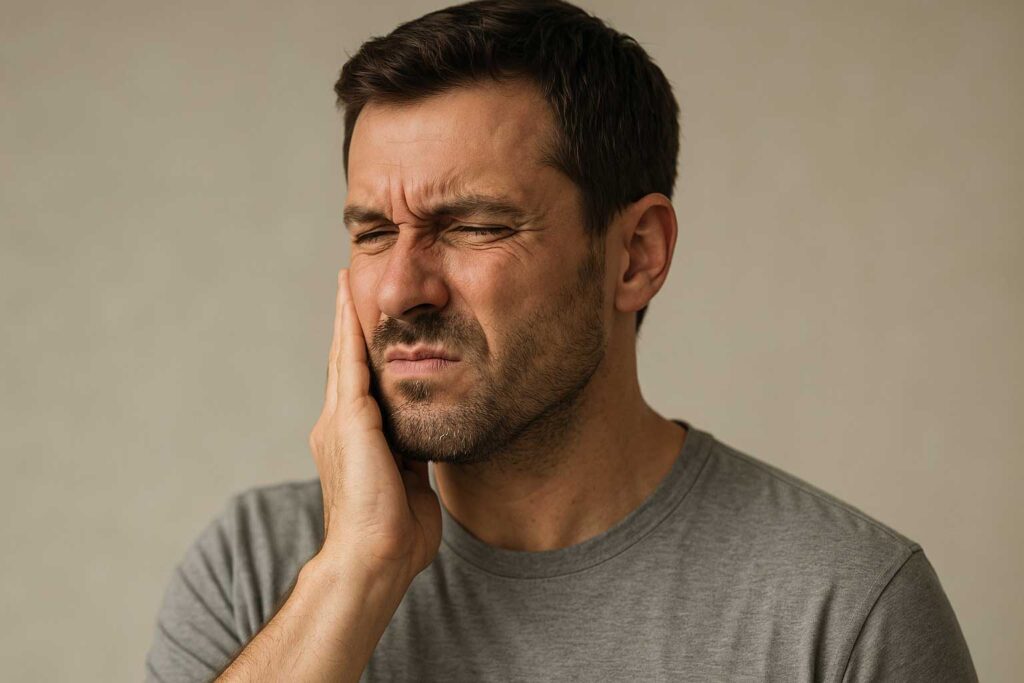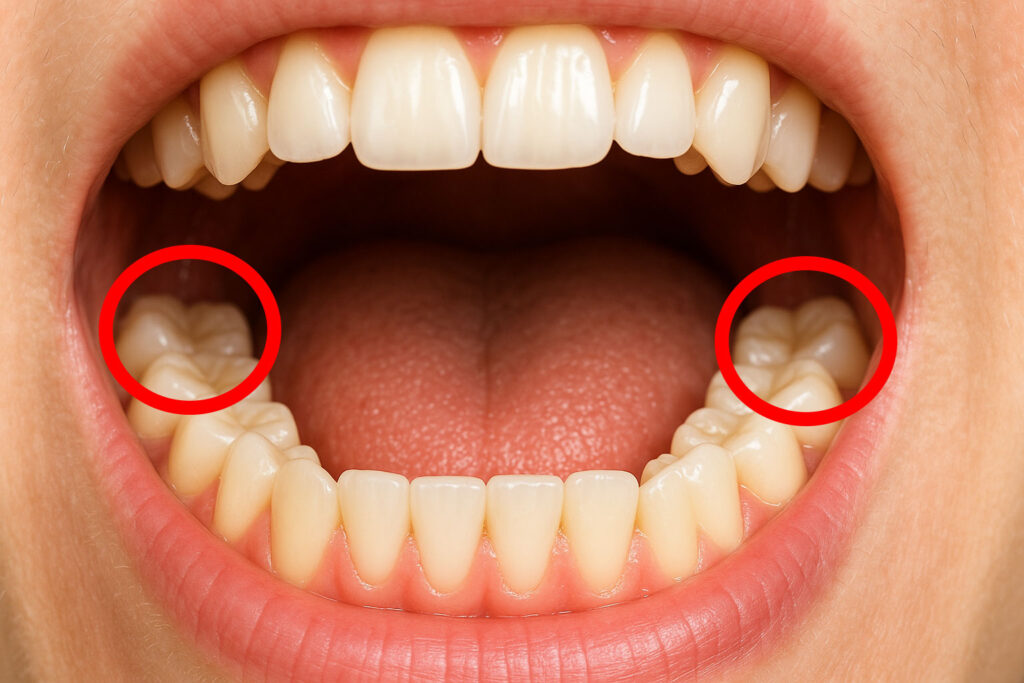In our daily practice at the dental clinic, we often see patients who wake up with facial pain, jaw stiffness, or visible tooth wear. Many of these symptoms have a common cause: bruxism, or unconscious clenching during the night, which puts strain on the temporomandibular joint (TMJ) and the masticatory muscles. The result can range from annoying morning headaches to tooth fractures and long-term joint problems.
This article aims to answer questions from those who want to understand how a bite splint can be the best ally for protecting their mouth and alleviating these symptoms.
Here we will explain clearly what exactly a bite splint is, in what situations it is indicated, how it is manufactured and fitted, and what care it requires. Whether you already suffer from bruxism-related discomfort or want to prevent possible future damage, you will find practical information to learn about its benefits, avoid common mistakes, and get the most out of this simple device. You will learn, step by step, how a bite splint can improve your quality of life and preserve your smile for many years to come.
>>> Do you live in Mallorca? Book your free first appointment <<<

Clinical indications
The bite splint is especially recommended in situations where it is necessary to protect the teeth and relieve tension in the jaw, preventing the progression of injuries and improving patient comfort.
Bruxism and teeth clenching
Bruxism, or the habit of unconsciously clenching and grinding the teeth (especially during sleep), causes accelerated enamel wear and fractures at the edges of the teeth. The bite splint acts as a protective barrier, absorbing the impact of parafunctional forces and preventing irreversible damage to the tooth surface.
Temporomandibular joint (TMJ) dysfunction
When the TMJ suffers tension or displacement (clicks, locking, crackling), local pain and limited mouth opening occur. The bite splint helps to reposition the jaw in a more comfortable position, reducing pressure on the condyle and articular disc, and promoting relaxation of the ligaments and recovery of normal movement.
Muscle pain and headaches of dental origin
Overuse of the masticatory muscles—masseters, temporals—due to excessive forces from nighttime chewing or emotional stress can radiate pain to the head and neck, causing morning headaches. Continued use of the splint reduces excessive muscle activity, interrupting
Types of bite splints
There are different materials and designs depending on the patient’s needs, each with its own advantages and characteristics.
Rigid acrylic splint
Made of hard acrylic resin, this type offers high wear resistance and excellent occlusal stability. It is customized to the millimeter in the dental laboratory based on precise impressions, ensuring a firm fit. It is ideal for severe cases of bruxism, as it withstands high forces without deforming. However, it may be less comfortable at first and requires a longer adjustment period.
Semi-rigid or soft splint
With a rigid acrylic interior and a more flexible outer layer, it combines protection and comfort. The soft surface cushions impact, reducing the feeling of a foreign body, while the core maintains stable occlusion. It is an intermediate option suitable for moderate bruxism or for patients who find fully rigid splints uncomfortable.
Polyurethane or thermoplastic splint
The thermoplastic material allows splints to be made without the need for an external laboratory: it is heated, fitted directly onto the teeth and, as it cools, takes on the shape of the teeth. They are usually cheaper and easy to replace, but over time they wear out and lose their precision. They are very useful as temporary or starter splints, before moving on to a more durable custom-made device.
| Type of splint | Material | Main indications | Durability | Recommended cleaning |
|---|---|---|---|---|
| Rigid acrylic | Hard acrylic | Severe bruxism, occlusal misalignment | 12–18 months | Gentle brushing + CPC mouthwash |
| Semi-rigid or soft | Medical silicone or EVA | Progressive adjustment, mild-moderate bruxism | 6–12 months | Rinse with water + neutral soap |
| Polyurethane / thermoplastic | Thermoplastic polyurethane | Quick adjustments, temporary cases | 6–9 months | Immersion in cleaning solution (tablets) |
Manufacturing process for the bite splint
The path to an effective bite splint begins in the dentist’s office and culminates with its delivery, fully adjusted.
Taking impressions and recording occlusion
First, the dentist takes precise impressions of the arch (upper, lower, or both, depending on the design) using impression materials (alginate or addition silicone). Next, they record the position of the jaw in relation to the opposing jaw using registration wax or digital intraoral scanning systems. This occlusal registration is key to reproducing the exact relationship of the teeth and avoiding interference.
Adjustment in the dental laboratory
h3>
In the laboratory, the technician pours the impressions and mounts the models in an articulator, a device that simulates jaw movements. The resin or thermoplastic material is applied to the appropriate support and molded to the dental contour. After curing and polishing, the splint takes on its final shape, with bite contact points designed to distribute pressure evenly.
Testing and fitting in the mouth
At the next appointment, the dentist checks the passive fit of the bite splint in the mouth, ensuring that there are no areas of excessive pressure. Small occlusal tilting adjustments are made with precision burs to balance contacts and allow smooth lateral and protrusive movements. Finally, comfort and retention are checked: the patient should be able to insert and remove the splint without excessive effort and feel it is stable during nighttime use.
How to use the bite splint
Recommended usage schedule
Most patients get better results by wearing it only at night, when bruxism is most likely to occur. In severe cases or with frequent daytime clenching, it may be recommended to wear it for short periods during the day (for example, during times of stress). Always follow your dentist’s instructions: excessive use can alter your bite, and insufficient use will not solve the problem.
Tips for initial adaptation
At first, it may feel strange or cause a slight increase in saliva. To make adaptation easier:
- Wear it at home for 10–15 minutes a day, biting down gently while sitting and relaxed.
- Practice opening and closing your mouth slowly with the splint in place to familiarize yourself with it.
- Avoid talking for the first few days until you get used to it.
If discomfort persists after two weeks, consult your dentist to check for possible adjustments.
Signs of correct fit vs. poor positioning
Correct fit:
- The splint fits without moving when you bite down.
- There are no painful areas when pressing with your finger on the gum or underlying tissue.
- It allows lateral and protrusive movements without intercepting or blocking the jaw.
Improper fit:
- It feels loose or moves when opening the mouth.
- It causes localized pain or ulcerations on the gums and mucosa.
- It prevents the mouth from closing completely or blocks mandibular displacement movements.
Detecting these signs early prevents major problems and ensures that the splint fulfills its protective and therapeutic function.

Care and maintenance
Daily cleaning and recommended products
To prevent the proliferation of bacteria and unpleasant odors, clean the bite splint every morning before storing it. Use a soft-bristled brush exclusively for this purpose, warm water, and mild soap or a specific cleaner for splints and prostheses (effervescent tablets). Avoid very hot water, which can deform the material, and abrasive toothpaste, which leaves micro-scratches where germs can adhere.
Storage and transport
When you are not wearing it, store it in its ventilated case, which protects the splint from contaminants and falls. Keep the case clean and dry; dry it in the air from time to time and clean the inside with isopropyl alcohol. When traveling, always carry the case in your carry-on luggage to avoid shocks and sudden changes in temperature.
Regular check-ups and refills
Although rigid splints usually last for several years, it is advisable to have them checked every six months during your dental check-up. The dentist will check for wear and tear, the integrity of the material, and the fit. In case of loss of retention or cracks, it can be refilled or rebuilt in the clinic to ensure its effectiveness without having to make a new one from scratch.
Remember
A well-fitted bite splint can stop teeth grinding and clenching, relieve muscle pain, and protect your enamel. Wear it every night as directed by your dentist and start noticing the difference in a few weeks.
Benefits and expected results
By incorporating the bite splint into your nighttime routine, you will see gradual improvements in several key areas of your oral and general health.
Reduced tooth wear
The bite splint acts as a barrier between the arches, absorbing the forces of clenching and preventing direct enamel-to-enamel contact. This significantly reduces wear on the incisal edges and molar cusps, preventing fractures and elongation of the tooth margins. In the medium term, this translates into less need for reconstructions, less tooth sensitivity, and preservation of the original anatomy of the teeth.
Pain relief and muscle relaxation
By balancing the occlusal load, the bite splint reduces hyperactivity of the masseter and temporal muscles. This breaks the cycle of excessive contraction that often causes facial and neck pain and morning headaches. Many patients report feeling their jaw is “looser” when they wake up, with reduced pain when chewing and greater freedom of movement when opening their mouth.
Improved sleep quality
Bruxism can interrupt sleep due to muscle tension and associated pain. By minimizing these discomforts, the bite splint contributes to deeper and more continuous rest. Restful sleep not only benefits oral health, but also improves mood, concentration, and energy during the day, promoting better performance in daily activities.
Possible complications and contraindications of using a bite splint
Allergies to materials and incorrect fittings
- Allergic reactions to acrylic resins or thermoplastics: redness, hives, or a burning sensation in the mucosa.
- Poorly fitted splint (too tight or misaligned): excessive pressure on the gums or teeth, which can lead to ulcers or localized pain.
Induced malocclusion problems
- Altered jaw closure after prolonged use of a splint with unbalanced occlusal contacts.
- Interference when chewing or during lateral/protrusion movements, which can cause new joint or muscle pain.
When to see the dentist again
- Joint or muscle pain that worsens upon waking.
- Difficulty or blockage when opening/closing the mouth.
- Recurrent ulcers or inflammation of the gums or mucosa.
- Feeling that “your teeth no longer fit” when you close your bite.
Remember: an early check-up allows the splint to be adjusted and prevents further complications.

FAQ about bite splints
Is wearing a bite splint painful?
When you first put on the bite splint, you may feel slight pressure or a foreign body sensation, but it should not be painful. If the splint fits properly, the discomfort will disappear after a few minutes. Persistent pain indicates that it needs to be adjusted: in this case, contact your dentist to relieve pressure areas.
How long does a splint last?
The average lifespan of a rigid acrylic splint is 2 to 5 years, provided it is properly cared for and does not suffer any blows or deformations. Soft or thermoplastic splints tend to wear out sooner, between 6 months and 2 years. Your dentist will tell you when to replace it based on the degree of wear and your progress.
Can it be used on children or only adults?
Although it is more common in adults, the bite splint can be adapted for adolescents with bruxism or TMJ problems, always after evaluation of maxillofacial growth. In young children, it is usually postponed until their teeth are more stable (advanced mixed dentition), as continuous dental changes would require frequent remakes.
Can I sleep with the splint in all night?
Yes. Prolonged use during sleep is precisely its function: to protect the teeth from the forces of nighttime clenching. Just avoid wearing the bite splint for longer than indicated (for example, beyond sleeping and a short nap) so as not to alter the occlusion.
Does the splint interfere with speech or breathing?
During the first few days, it may slightly alter the pronunciation of certain sounds (“s,” “z”) and cause a slight increase in saliva. However, most patients adapt within a few minutes and there is no impact on nasal breathing.
What should I do if I lose or break the splint?
Contact your dentist as soon as possible. If it is a rigid model, they will be able to reload it or make a copy based on the impressions stored in the laboratory. For soft or thermoplastic splints, they may give you a temporary replacement splint while a new one is being prepared.
Is there any specific long-term maintenance?
In addition to daily cleaning, have your bite guard checked every six months at the dentist’s office for wear, cracks, or changes in fit. Regular maintenance prevents complete replacements and ensures continuous protection.
 Whatsapp
Whatsapp




